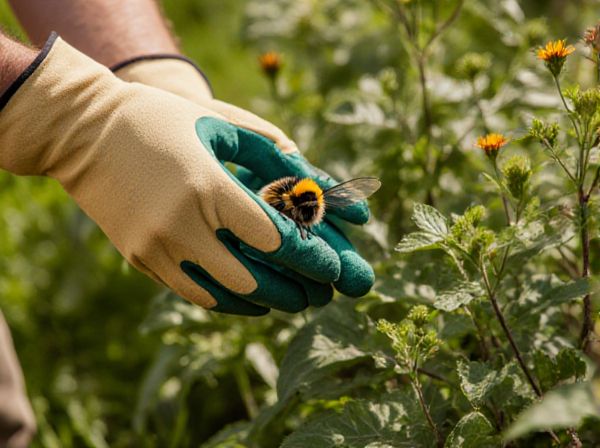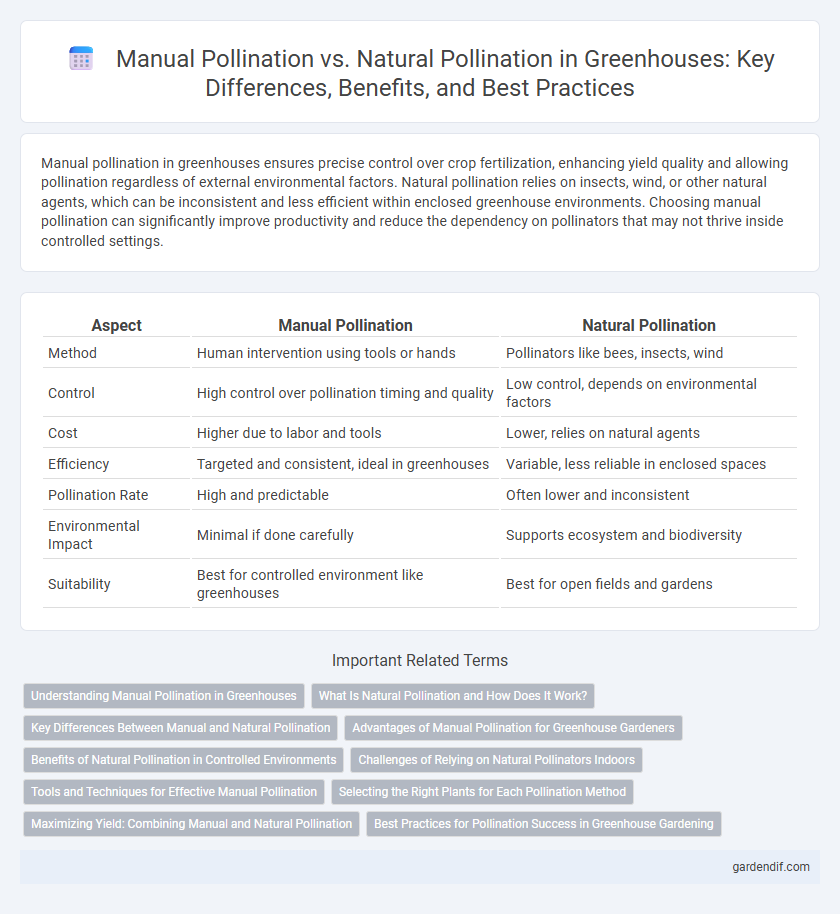
Manual Pollination vs Natural Pollination Illustration
Manual pollination in greenhouses ensures precise control over crop fertilization, enhancing yield quality and allowing pollination regardless of external environmental factors. Natural pollination relies on insects, wind, or other natural agents, which can be inconsistent and less efficient within enclosed greenhouse environments. Choosing manual pollination can significantly improve productivity and reduce the dependency on pollinators that may not thrive inside controlled settings.
Table of Comparison
| Aspect | Manual Pollination | Natural Pollination |
|---|---|---|
| Method | Human intervention using tools or hands | Pollinators like bees, insects, wind |
| Control | High control over pollination timing and quality | Low control, depends on environmental factors |
| Cost | Higher due to labor and tools | Lower, relies on natural agents |
| Efficiency | Targeted and consistent, ideal in greenhouses | Variable, less reliable in enclosed spaces |
| Pollination Rate | High and predictable | Often lower and inconsistent |
| Environmental Impact | Minimal if done carefully | Supports ecosystem and biodiversity |
| Suitability | Best for controlled environment like greenhouses | Best for open fields and gardens |
Understanding Manual Pollination in Greenhouses
Manual pollination in greenhouses involves the deliberate transfer of pollen from the male anther to the female stigma, ensuring controlled fertilization especially in environments lacking natural pollinators. This technique improves fruit set and yield consistency by overcoming limitations such as inadequate insect activity or climate factors within enclosed spaces. Effective manual pollination requires precise timing, the use of tools like brushes or cotton swabs, and knowledge of the crop's flowering stages for optimal results.
What Is Natural Pollination and How Does It Work?
Natural pollination in greenhouses occurs when pollinators such as bees, butterflies, or wind transfer pollen from the male anthers to the female stigma of flowers without human intervention. This process relies on the presence of natural pollinators or environmental factors like airflow to ensure fertilization and fruit development. Effective natural pollination enhances crop yield, biodiversity, and plant health by mimicking outdoor pollination dynamics within the controlled greenhouse environment.
Key Differences Between Manual and Natural Pollination
Manual pollination allows precise control over pollen transfer, enabling targeted fertilization and increased crop yields in greenhouse environments. Natural pollination relies on pollinators such as bees and wind, which can be inconsistent and less reliable indoors. Key differences include labor intensity and cost efficiency, with manual pollination demanding more human intervention but ensuring higher success rates compared to natural methods.
Advantages of Manual Pollination for Greenhouse Gardeners
Manual pollination in greenhouses ensures targeted and efficient pollen transfer, leading to higher fruit set and yield consistency for crops such as tomatoes and cucumbers. This method minimizes dependency on external pollinators like bees, which may be scarce or inactive due to controlled environmental conditions. Controlled manual pollination also enables precise timing and improved crop quality, reducing pollination failures and maximizing greenhouse productivity.
Benefits of Natural Pollination in Controlled Environments
Natural pollination in greenhouse environments enhances genetic diversity and promotes healthier crop development by facilitating cross-pollination through pollinators like bees. This method reduces labor costs associated with manual pollination while ensuring consistent fruit set and improving crop yield quality. Maintaining a balanced ecosystem within greenhouses supports natural pollinators, fostering sustainable and resilient agricultural practices.
Challenges of Relying on Natural Pollinators Indoors
Relying on natural pollinators indoors poses challenges such as limited insect activity due to confined spaces and controlled environmental conditions that reduce pollinator attraction. Inconsistent pollination rates can lead to uneven crop yields and lower fruit quality compared to manual pollination techniques. Furthermore, the absence of wind and natural predators disrupts the ecological balance essential for sustaining healthy pollinator populations inside greenhouses.
Tools and Techniques for Effective Manual Pollination
Effective manual pollination in greenhouses relies on precise tools such as fine brushes, cotton swabs, and electric pollen applicators to transfer pollen directly from anthers to stigmas. Techniques involve gently collecting pollen in the morning when it is most viable, then evenly applying it to receptive flowers to maximize fruit set and yield. Regular monitoring of humidity and flower readiness ensures optimal conditions, preventing pollen clumping and enhancing manual pollination success.
Selecting the Right Plants for Each Pollination Method
Choosing plants suited for manual pollination in a greenhouse often involves selecting varieties with large, accessible flowers and visible pollen to facilitate efficient hand pollination. For natural pollination, selecting plants that attract pollinators such as bees or beneficial insects, including those with strong scents and nectar production, enhances successful fruit set. Integrating plant species that match the chosen pollination method optimizes yield and supports the overall greenhouse ecosystem.
Maximizing Yield: Combining Manual and Natural Pollination
Maximizing yield in greenhouse crops involves integrating manual and natural pollination techniques to enhance fruit set and quality. Manual pollination ensures precise pollen transfer in controlled environments, while natural pollinators like bees contribute to genetic diversity and improve pollination efficiency. Combining both methods optimizes crop productivity by leveraging the strengths of biological pollination and human intervention.
Best Practices for Pollination Success in Greenhouse Gardening
Manual pollination in greenhouse gardening ensures precise control over pollen transfer, which is essential for crops like tomatoes and peppers that rely on effective pollination for fruit set. Natural pollination methods can be supplemented by introducing bumblebees or using oscillating fans to mimic wind, promoting pollen dispersal within enclosed environments. Combining manual techniques with environmental controls maximizes pollination efficiency, leading to higher yield and consistent crop quality.
Manual Pollination vs Natural Pollination Infographic

 gardendif.com
gardendif.com